
“Tell me who I am”
An interview with Belgian art collector Galila Barzilaï Hollander
03/04/2017
“Don’t be shocked by the house, it's really uninhabitable,” says the Belgian art collector Galila Barzilaï Hollander as she opens the door. She is dressed in Issey Miyake, which has become her trademark – today she's all in black and white, like a chessboard. A sign on the red brick wall by the door reads “Tell me who I am”, and we return again and again to this fundamental yet also sometimes ironic question over the course of our conversation, which will last more than two hours.

Galila’s House. Photo:
While Galila makes coffee in the kitchen and I stand in the jam-packed hallway between the kitchen and the work room, I try to remember what this house reminds me of. Apart from the fact that I've never imagined that a living space like this could actually exist, one that is completely full of art and has hardly one square metre of space for just living. There's art on the walls, on the floor, in boxes, on shelves, unpacked and still packed up. This is art that must be manoeuvred through, art that you run into at every turn, art that sometimes needs to be stepped over. I imagine that Galila's collection has distant similarities to the Centre Pompidou in Paris designed in the 1970s by Richard Rogers, that once scandalous museum whose façade resembles a dress that has been turned inside out. Except that in Galila's case it is she herself who is projected inside out through the prism of her collection. Her life, her thoughts, her emotions, her exuberance and possibly also her doubts. In this sense, she is definitely the owner of one of the most personal collections of art in the world. It is a collection that does not lie, does not pretend and does not flirt. At the same time, it proves that art can be – and is – just as organic a part of life as one's family, children, individual experiences and perception of the world.
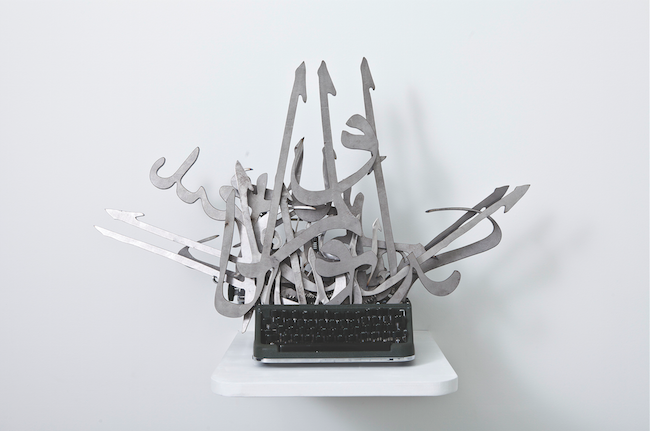
mounir fatmi. Union Impossible, 2011. Galila’s Collection. © the artist. Photo: Nicolas Suk. Exhibition “Entre deus chaises, un livre” at Boghossian Foundation - Villa Empain in 2014
Galila Barzilaï Hollander's collection has more than 20 different thematic and conceptual subdivisions that have developed and are added to impulsively: eyes, chairs, money, measuring devices, gender issues, books, recycling, white, eggs, drawers, steps, etc. All of the themes are somehow linked with Galila's life and herself. The artists, their origins, ages, genders and status in the art market are of no meaning – what's important is the energy that forms between a specific work of art and Galila herself when she looks at it. Each work of art in her collection is in some way a fragment of a giant puzzle that she is putting together intuitively but also systematically. The collection is like a tunnel whose various zig-zags are still unknown to her, but she clearly knows that there's light at the end of it – a mirror/solution to the story about herself.
In the art world, Galila is known not only as an intense and passionate attendee of art fairs but also for the way in which she selects artwork – by trusting her eye and literally “scanning the field”. She usually only asks for the name of the artist after she has already decided to buy a work of art, which astounds many a gallery owner bound by the system's stereotypes.
A vivid example of Galila's healthy self-irony in relation to the current realities of the art market is the Warhol-ish car parked in the courtyard of her house that's covered with VIP cards from art fairs. She designed the car herself. There's a sarcastic sign reading “V.I.P.” where the licence plate should be and a screen in place of the steering wheel and control panels. Here, Galila has surreally replaced brutal functionalism with spirituality, turning a macho mode of transportation into a cinema that features video works from her collection. The house itself was built in the 1970s and also embodies certain pages from her life that no longer exist. To wit, Galila's husband Jacques Hollander was a passionate antique collector, and the collection of antiques that the couple amassed over 30 years of marriage was housed right here. But when her husband died, Galila sold the collection in an auction at Christie's, thereby symbolically turning the page and beginning a new stage that she now calls her “second life”.
However, the beginning of this new stage was quite funny. Back in 2005, less than a year after her husband had died – and also, coincidentally, on their former wedding anniversary – Galila took a trip to New York City to seek some solace in the city where, as she says, “one does not feel alone”. She ended up at the Armory Show, an art fair that she had incorrectly assumed to be a show of ancient armour. Even though today it sounds like a joke that has become the stuff of legend, at the time it was actually a very serious matter, because that fair was Galila's first encounter with contemporary art. Needless to say, during her first fifteen minutes at the Armory Show she had already bought the first of what would eventually grow to more than 1000 works of art in her collection today. That first work of art is still in her home – it's a drawing on paper consisting of the word “why” followed by a question mark and repeated 11,522 times, hypnotically drawing the viewer into the black hole of a parallel world. At that point in her life, “why” was a desperately existential word – an attempt to answer the unanswerable regarding why her husband had had to leave this world in such an untimely manner. Over time, however, the word has acquired countless layers and become much more nuanced, a why that seeks answers to fundamental and sometimes seemingly mundane questions in her life.
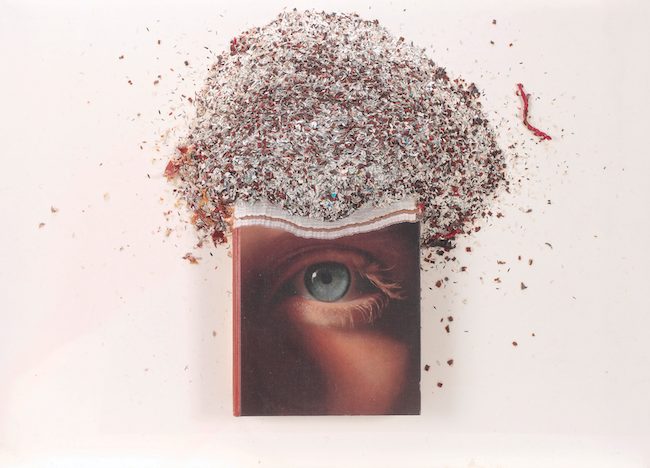
Jonathan Callan. Thought and Ideals, 2010.Galila’sCollection. © the artist. Photo: Nicolas Suk. Exhibition “Entre deus chaises, un livre” at Boghossian Foundation - Villa Empain in 2014
The next crucial step in this process will be the art space that Galila is creating. It is located in Brussels, very near to the well-known WIELS centre for contemporary art. The 1500-m2 space is currently still an active construction site, but Galila is convinced that by next year it will already become the new home of her art collection. It will be a puzzle of exposition spaces that will finally provide an answer to that most fundamental of questions: “Tell me who I am...”
I wanted to ask you about eyes, because that's the first thing I noticed when I entered this house. While you were making coffee, eyes were looking at me in every possible way and medium. How did your passion for eyes begin, and what do eyes mean for you as a symbol?
You know, I did not decide to collect eyes. So this story does not have a classic beginning. To be honest, I don’t remember which was the first work of art with an eye that I bought. I only know which work of art was the first one I bought, the beginning of it all. It was like a shock, and you always remember a shock. I never intended to collect a theme, somehow it happened that the eye was there and became a theme.
But nowadays, at least judging by the quantity, it looks like you are consciously developing the eye theme.
No, I don't select anything. I just let things happen. The process of discovering a work is very similar to the influence of the unconscious action of marketing on your subconscious. That's what marketing and publicity is – how to make you buy something without really analysing and seeing. I don't buy art like in a supermarket, but I do think it is something that goes beyond my thinking. I don’t look and think: “Is it good? Who is he/she? What is this artist supposed to say? What is the meaning of his work, what is the context?” I don’t do that. I scan. When I visit a booth at an art fair, I simply go, without prior purpose or priorities. I look without seeing, and I see without looking. I am aware, and I am not aware. It is a very bizarre phenomenon, but this is the way I choose. And very often I feel that my choice is right.
As proof, very often I find out that my intuitive choices are, later on, confirmed by the acknowledgment the artists receive from museums, institutions, important collectors, etc. One very small and recent example: I have just learned that the Arco Foundation has included in this year’s selection a young and emerging Spanish artist whose work I already possess. My true satisfaction and joy is to say that I have the first edition, while the museums X, Y and Z have edition number two!
When I buy, I very often do not even know the name of the artist. Something just catches my eye, without any knowledge or analysis. I look, and it is meaningful, it has something to do with my life, my story, my aesthetics. Sometimes it's unconscious, and only later on do I understand. I think my collection is like a puzzle. Every work must fit into it, and at the end it's going to give you an image. This image will tell you my story, it will tell you who I am. I feel that my collection (that is, my choices) represents my personality projected in a sincere way onto something that you can physically touch and see. I cannot lie in my choices.
As said before, I do not consciously choose the artist, but my general approach is to focus on young and emerging artists. Putting aside the financial aspect of buying well-known and blue-chip artists (unfortunately, the sky is not my limit), my true and deep emotional experience is in “hunting” and discovering. I feel very happy when someone visits my collection and admits to hardly knowing any of the artists. It is at this specific moment that the sense of sharing is great, letting people discover not only my universe but also new names. I admit that, as far as I’m concerned, when I visit a collection that includes all kinds of names I already know, I feel “hungry”, as if I have not had enough to eat. This might explain a little bit why I am completely hermetic, completely immune to some of the things that are highly considered. They don’t address me. This desire for prestige – look, I have this and that, and everybody will say “Wow!” Which is all OK, but for me the collection has nothing to do with prestige or with money. It's not social. I didn’t decide to collect as a social game.
A curator once asked me a question: “What does art represent for you?” I didn’t really think how to make a very intelligent and sophisticated answer, it just escaped my mouth – I said that art is like a cocktail made of oxygen, food and sex. And it really is like this. You can’t do without these things (at different levels...).
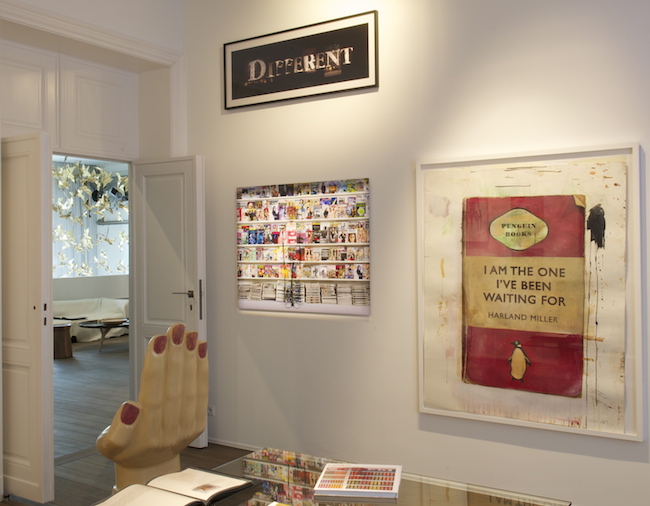
Inner Journeys exhibition at Maison Particulière (April - June 2013). Photo: Courtesy of Maison Particulière
Actually, your story of collecting began with the amazing collection that you made together with your late husband.
(Laughs.) I think my husband would kill me if he saw what I've done since then. Or he'd divorce me and put me in the insane asylum. He started to collect when he was seventeen years old. He didn’t know anything about antiques at that time, no family background in it. He was simply born a natural aesthete, he really saw quality and he had a very good nose. He was able to understand all cultures without having the knowledge. Knowledge came later, by reading a lot and visiting museums. His first buys were purely instinctive, but he bought right, he saw it. It was as if he had a laser in his eyes – so, this is good, this is good.... My family also had no links to culture, we did not go to museums. I didn't know anything. It was all just a giant desert to me. But maybe I had an eye – that eye again! – which I continue to develop.
When I met my husband, he already had a small collection, and it grew noticeably over the years and with greater financial means. We always bought together, but he was the one who made the final decisions, because he was the knowledgeable one. But I was happy with whatever we bought, so it was all very smooth. Nevertheless, I didn't share the same level of zeal, and every now and then I would ask him, “Why do you have to buy every week? Don’t you have enough, are you not happy?” I didn’t understand it. And now that I'm doing the same thing, I always think that he sent me a curse from where he is now, as revenge.
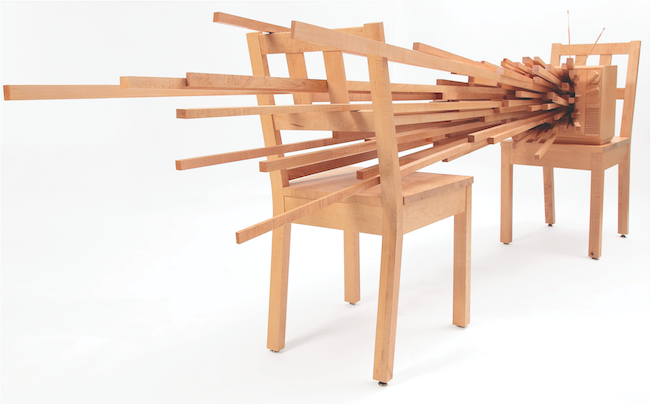
Darren Foote. Television, 2008. Galila’s Collection. © the artist. Photo: Nicolas Suk. Exhibition “Entre deus chaises, un livre” at Boghossian Foundation - Villa Empain in 2014
But what was his answer then?
He didn’t answer. He just said – this is me, this is my life. Today I would reply the same. The only difference with me is that he bought and also sold; I do not sell. He was a wonderful businessman. We went to the flea markets at five o’clock in the morning, looked and searched – there was no Internet back then. It was a kind of hunt, and he liked that. Today when you see something, you can immediately google it and know everything about it. He had a good eye, he saw what others did not see and did not appreciate. He bought the ignorance of others (rather cheap), and then he sold. It was a game for him, but at the same time he was a true collector. People in the antiques world, experts and important dealers respected him and his choices.
I liked all of that, but I didn't understand it fully. We had a very beautiful house, a great collection, but something was missing. Today I understand that the missing point was the energy.
Coming back to my own collection, 95% of my artists are young and emerging. I try to meet them, to get to know them. It's hard for me to explain how come, but I always have a great relationship with them, and that leads to commissions, it leads to ideas. I don't tell them what to do; I tell them to tell my story with their language.
The works I commission are very personal and deal mostly with archiving, storing, memory, souvenirs, all related to my life and existence. Obviously, by sharing my intimacy with the artists, it naturally leads to a very close and deep relationship. I will not describe these commissions, they are my secret world....
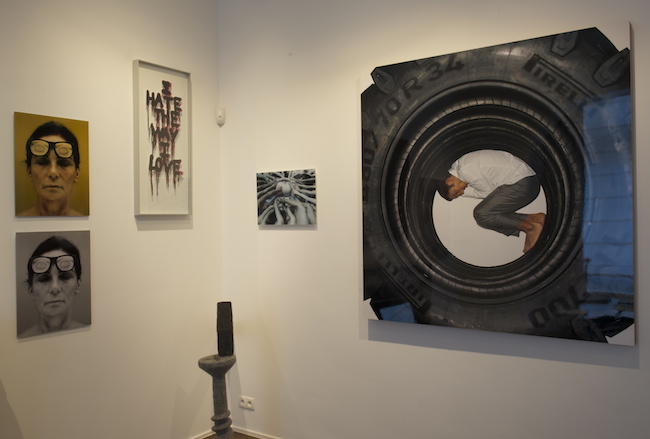
Inner Journeys exhibition at Maison Particulière (April - June 2013). Photo: Courtesy of Maison Particulière
It seems that contemporary art has brought you a certain sense of balance....
Of course, it's balance. It's a way for me to express myself, but through others. Sometimes, when you read a well-written book or text, you say, “That's exactly what I was thinking, so clear, so precise, but I never knew how to say it like this.” This is the same thing.
Isn't it the case that, when an object in the collection changes, your own personality also changes? I assume that you've become more open.
Absolutely. You know, this year I was awarded the Arco Foundation Collectors Award. Naturally, I was expected to make a little speech. I didn't know what to say and had not prepared my speech. I decided to take a risk and just surrender to the situation by improvising, and I told them my speech might seem very chaotic – similarly to my collection – chaotic but with a guiding line. Among the things I said was that I discovered art after my husband died, and for me it was like a rebirth. I had the great privilege of a second chance; not all of us have a chance to have a second life. It is the best anti-aging therapy; it makes you feel like you might reach two hundred years old.
When I finished speaking, some people came up to me and said, “Your speech was nice and touching.” That was nice to hear (good for the ego), but it did not really affect me. What did deeply impress and touch me were a number of widowed women who came up to me afterwards, saying, “You gave us hope by telling about this second life of yours.” When I was speaking, I had no idea in my head about delivering a special message – I simply spoke about my life and my reality. But that's what those women heard in what I had said, and they came to me spontaneously to tell me that I had really given them something to think about. Maybe that's what art is all about. Maybe art is an answer to many things. I know it helped me to compensate for loneliness, because all of a sudden I was surrounded by people, by energy, by art, by things, so it became like another family. Of course, it's not like a real family – I know what a real family is and what the real relationships in a family are, so I cannot say that art is my family. But it is family in a way.

Elodie Antoine. Chaises à bascules, 2009. Galila’s Collection. © the artist. Photo: Nicolas Suk. Exhibition “Entre deus chaises, un livre” at Boghossian Foundation - Villa Empain in 2014
In 2013 you sold the extraordinary cabinet of curiosities – the amazing collection you made together with your late husband – at Christie's. How did you feel afterwards?
For ten years the collection remained at home, untouched. It had to be sold for personal reasons. When I sold it, in a very bizarre way I felt relief.
The physical existence of the collection at home kept the memory of my husband very much alive. Selling the collection was also a way to say, “OK, I have to turn the page.” Obviously, it was difficult to turn the page when you have everything here. It was emotionally impossible. And I couldn’t live with these two worlds. I never thought that I would be able to sell the collection. Sometimes bad things bring good things.
Your first visit to the Armory Show has already become a legend – it was like being cured after a personal tragedy. After so many years of collecting, and with a background in psychology, what do you think – does art really have a healing/therapeutic effect?
I think art can take the place of a psychotherapist. When you go to a therapist, you're sitting there and he or she doesn’t say anything to you, you just talk. Instead of paying someone (I mean, it's much more expensive to have a collection! [laughs]), you have this dialogue with a work of art. It makes you think. And sometimes it reveals things. For example, I would have never said about myself that I am an obsessive person. I don't think so. But I have a lot of artwork that could say that I am obsessive. I have a lot of drawings, all of these small things.... Maybe there's a part of me that is obsessive, but it's not a dominating part. I've got something of the schizophrenic in me – there are countless personalities within me at the same time. But what's good is that there's not one personality that is dominating. The whole thing is so mixed up that people don’t know who I am (laughs).

Tajna Boukal. Million Dollar Babe, 2010. Photo:
You can make many puzzles on the different themes that you are collecting...
For example, I have a very big collection of artwork and objects that are devoted to the theme of money. As a small anecdote, in reference to this theme, several years ago I participated in an exhibition where part of my money artwork was exhibited. When introduced, the representative of the institution said, to my surprise, something like, “Galila likes money, this is why she has a collection of money.” To which I answered that I do not like money. On the contrary, I've always had problems with it – with the concept of money, the value of it. And that's connected with my own life. I know what it means to be on the street, in the most literal sense. I know what it's like to have very little money, to have none at all, to have enough and a little above.... I know the value of money. A hundred euros is a lot for someone who doesn’t have a single penny, but it can be nothing for someone else. The notion of money is very complex. I feel that the more financial means I have, the more humble I become in terms of money and in my values. My values are changing. I am not able to spend a lot of money on things that seem trivial to me, things with no value inside.
In connection with the money artwork, and maybe as a natural continuation of it, there is another theme: the measure (measuring devices). Measures and value are quite connected. And this collection began quite by accident, too. Next to my thematic collections, there are also conceptuals. For example, recycling and recuperation. Beyond the obvious need to recycle today, I like the concept of doing something from nothing with very little means. I glorify and am fascinated by creativity and the mental creative process. On my humble level, I try to apply this “nothing from something” in my day-to-day life. I admit, though, mostly in the way I dress and wear jewellery.
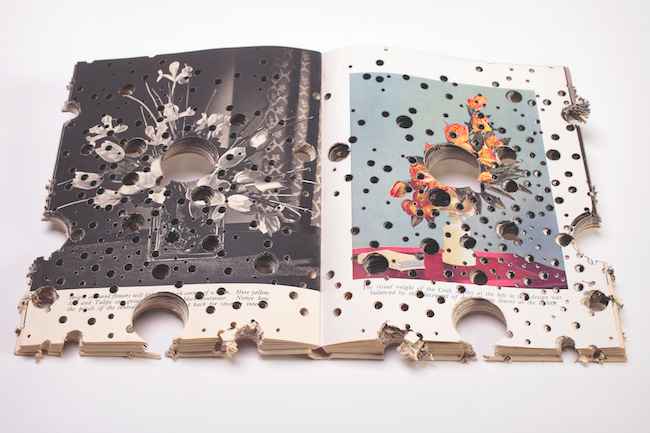
Jonathan Callan. Around the house, 2006. Galila’s Collection. © the artist. Photo: Nicolas Suk. Exhibition “Entre deus chaises, un livre” at Boghossian Foundation - Villa Empain in 2014
Yes, you are famous for wearing only Issey Miyake.
Miyake is my style. Miyake has two lines: Pleats Please (reasonably priced) and a more sophisticated line (rather expensive). I go for Pleats Please. I started to buy it in the 1980s and still wear the very, very first piece I bought. Miyake is the contrary of fashion. It is the most respectful approach to dressing, leaving the liberty of expression to the women herself – in the Issey Miyake philosophy it is the woman who creates the clothes and not the clothes that create the woman.
I had the opportunity and privilege to meet Issey Miyake a few times. The first time was by accident. This is how I discovered him. (My whole life consists of accidents). I could write a thesis on him.
Coming back to the issues of money, value, creativity, recycling, etc., another small anecdote on how these issues are part of my life: While waiting for a meeting with my architect, wishing to protect myself from the rain, I went into a little junk store and came out of the store five minutes later with six pairs of earrings for 26 euros all together. And they look terrific. Everyone said, “Ohhh, look what you bought!” My fun in life is to look like a million dollars with one hundred dollars. It's very playful. And also my collection is very playful, with a lot of humour. I am serious, but I don’t take things seriously. So, it's all dynamic – me and my collection, it's like ping-pong. I choose my collections because they embody me, and I feel that the same thing happens with the artists.
This interview sounds like a ping-pong of my thoughts, going from one subject to another without necessarily a connection between the previous paragraph and the next.
Coming back to my relationship with the artist, I feel very privileged to share with some of them a great affection and care and a very kind reciprocity. The spontaneous and generous presents I occasionally receive from my artists are a token of this very special connection we have. I feel it is emotional and sincere on both sides.
Inner Journeys exhibition at Maison Particulière (April - June 2013). Photo: Courtesy of Maison Particulière
Do you have any red lines in your budget that you never cross?
Generally speaking, I cannot afford the seven-figure prices and very, very rarely the low six figures....
But, to come back to your question, this is something that I learnt from my husband – how can you judge a piece of artwork in terms of price? Is 1000 too much, is 5000 too much, is a million too much? We never talked about it, but in a way those are valuations based on intuition. And there's some truth in it. I don’t get the impression that I overpaid for something, that it's not worth it. It can be valued according to the time the artist really worked on it. But at the same time you can also say that one minute of genius is worth a lifetime of labour.
Here we come back to my collection of measuring devices. There is no scale, there is no unit of measurement for measuring the price of a work of art. Sometimes there is a very, very good artist that I consider is underpaid. Intuitively, I think that some artists are overpaid, but they are overpaid because the market is crazy. Because the market is also full of people who buy for the wrong reasons, and they drive the prices higher. One time, at a quite good gallery, I saw a photograph by a young artist – it was really good, you could tell that the artist was talented, but he didn't have any exhibitions on his CV, nothing. I asked about the price of that photograph, and the gallerist stated some insane price. I asked, “OK, how do you justify the price, seeing as the artist is very young?” And the gallerist told me, “Well, I think he's going to have an exhibition at this museum, and probably he's going to have an exhibition at that museum....” I said, “Look, he's just out of school, and maybe this is the only good work of art he will have and nothing will happen afterwards. You are killing him from the beginning.” I really liked the photo, but I didn’t buy it. Because I thought this isn't normal, and it was completely not doing justice to the artist.
And on the other hand, sometimes at auctions I see artwork by artists who are already in my collection, and they are estimated very, very low out of a fear that they will not sell. Sometimes I participate myself. I bid just to keep his price for the artist's sake and interest, not for me. I think it's a complete mistake for galleries to put young, emerging artists into the auction sales. You never know what it can reach. But of course, sometimes you can take advantage of it. At an auction in London there where three photos by a French artist who is quite well known. The estimates were very low, much below her market price. I assume that people not knowing her work might have judged only by the estimation, although the works were very good, and therefore did not bid. As a result, I got all the three. I was happy for myself but unhappy and very sad for the artist, because when you search her name on the Internet, you see that this artist's work has sold for so little. People do not understand it, people don’t know the mechanism.
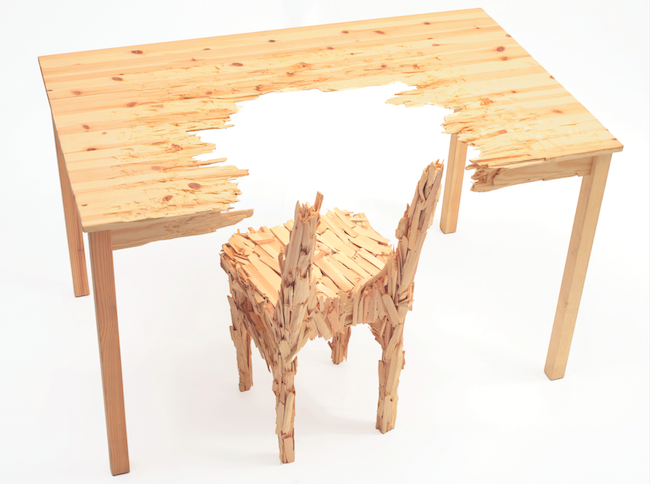
Adrien Petrucci. The Table and The Chair, 2011. Galila’s Collection. © the artist. Photo: Nicolas Suk. Exhibition “Entre deus chaises, un livre” at Boghossian Foundation - Villa Empain in 2014
Does that mean that there really are so many people in today's art market who value a work of art simply according to its price?
I think the price has a psychological factor. I don’t understand all pieces that sell for millions. I feel that some prices are out of proportion. Coming back to the notion of value, I sometimes feel an inner conflict regarding how and where to put the money into (health, education, other universal issues). On the other hand, who am I to judge? I just don’t know how to deal with it. I recently read about a very rich Spanish art collector – she's a billionaire, one of the richest women in Spain. A lot of her collection is female portraits. She has a Modigliani, a Picasso – she pays 20 million for this and 60 million for that. So, maybe if I was a billionaire and I saw a beautiful Modigliani, maybe I would go for it. I don’t know. Maybe what I'm saying today is not relevant in another situation.
You're famous for actively attending art fairs. Aren't there too many art fairs today?
Yes and no. Of course, if I was a retired person, I could spend my life at fairs. I'm now leaving for Paris – they have two fairs there now – and then in April I'm going to São Paulo, in May there's Buenos Aires, there was a fair in Mexico in February, then Hong Kong. I do not go to all of them, because I'm afraid of myself. I know that I will always find something. I cannot stop myself, it's like an addiction. And if you are addicted, the only way is to not go to the casino – you should be forbidden from going there. Actually, I should be forbidden from the art galleries as well. And the problem with art galleries is that galleries give me the opportunity to buy, they give me good conditions and time, and how can I say no? But, unlike a casino addiction, I know my limit. As I said, I don’t overpay. But when you buy many pieces, it's like “just one more”, “just one more”...and at the end you have a lot. That's my problem.
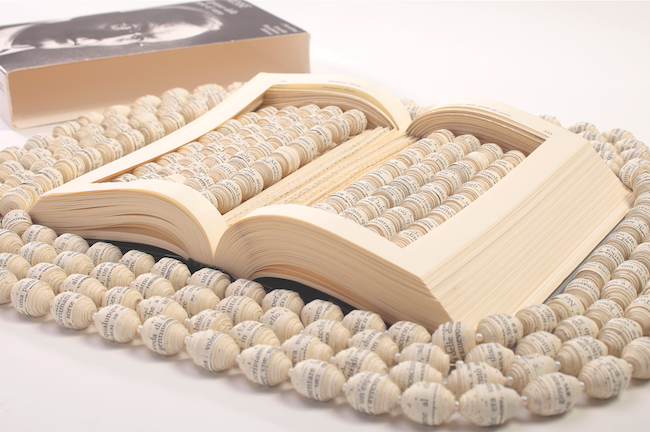
Sabrina Mezzaqui. Il giuoco delle perle di vetro, 2010. Galila’s Collection. © the artist. Photo: Nicolas Suk. Exhibition “Entre deus chaises, un livre” at Boghossian Foundation - Villa Empain in 2014
Does that mean that you have a separate budget for each art fair?
No. I never have a budget. I can only repeat how grateful I am to the galleries for providing me the best terms and conditions for my acquisitions. The reason is they deeply know how committed I am to promote the artist in all possible ways, such as lending to exhibitions and even more, myself proposing certain artwork for exhibitions whenever appropriate. As a recent example, one of my proposed artists to be included in an exhibition was not only selected, but the museum used the image of his work as the front cover of the catalogue and poster. What better can an artist expect?
Isn't that an art collector's main mission and responsibility at the same time?
I think it's their basic responsibility. Some collectors don’t want to lend. I can understand this refusal only if the work is very fragile or complicated to transport. I never refuse. Another part of the collector's contribution, in my point of view, is to help make connections with galleries. A suggestion or recommendation from a collector can open doors for artists. I myself have had experience with a few cases of galleries “picking up” and exhibiting artists they discovered in my collection or artists I took the liberty to recommend.
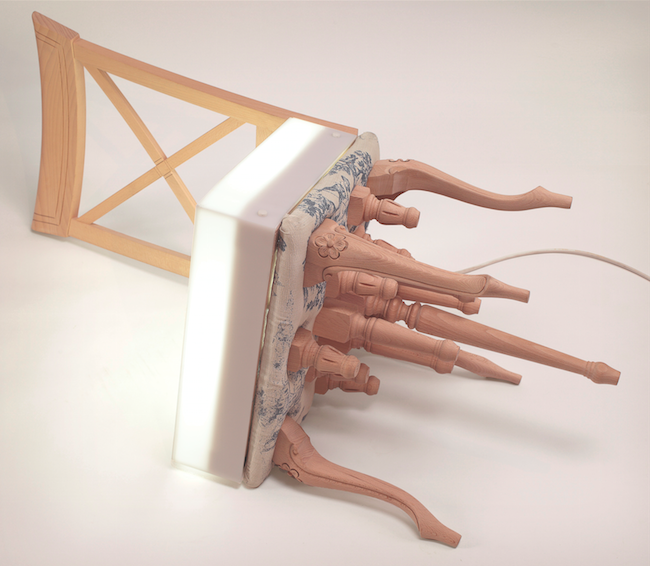
Antonio Diaz Grande. Vigilia, 2009. Galila’s Collection. © the artist. Photo: Nicolas Suk. Exhibition “Entre deus chaises, un livre” at Boghossian Foundation - Villa Empain in 2014
You also have a lot of objects in your collection. For example, chairs and books. What do you think – is a chair a philosophical or a practical phenomenon?
It can be practical, but not many chairs in my collection are to be used. A chair is something very basic, it expresses togetherness. When you come in, there is this – take a seat. It's like welcoming something. It has something to do with communication. A chair as an object is quite puzzling. If it is so banal, why do we not have just two or three models of chairs and that’s it? Why do we have a new chair on the market every year? Why are they so present in our society? In my collection, the chairs are pure creative objects, all different and telling their personal story.
I am also very much into aesthetics. Some people say that aesthetics are not so important, that the concept is the main thing. I cannot enjoy something that is ugly but says some very philosophical things. I don’t understand it. I prefer to read a book on that philosophical issue and not have something so ugly that I can’t stand it.
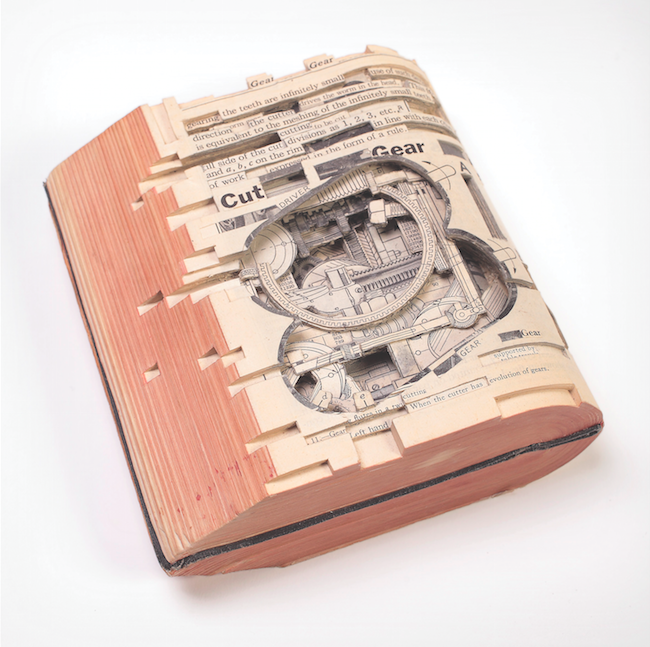
Brian Dettmer. Cutting. Gears, 2006. Galila’s Collection. © the artist. Photo: Nicolas Suk. Exhibition “Entre deus chaises, un livre” at Boghossian Foundation - Villa Empain in 2014
But books – are they knowledge, or are they also objects?
That's another part of my story. When I go to a bookshop and I see all these huge numbers of books, I feel so bad, because I don’t know how I can absorb all of this information, how I can read it all in one lifetime. And the more you know, the less you know. And you feel like nothing in this universe. So, I transform this pain into pleasure. Instead of reading them, I am doing objects of them.
My mother died a few years ago (I didn’t have a good relationship with her), and she had a lot of books. I'm going to use her books that I didn’t throw out to make a sculpture on the façade of the building that you saw this morning. There is an artist who is going to work on it, I just need to get permission. And she, for her part, must find a technical way of how to make it an outdoor piece.
You said that your collection covers at least twenty different themes and concepts. Is there a theme that has emerged only very recently?
I have a theme that can be shocking when seen the first time. It's about Hitler. Of course, it does not glorify him. There is an Israeli video artist who made videos about Hitler, very radical works. One of his works is a real museum piece, but museums are afraid to show it. It is a hunter’s trophy with the head of Hitler instead of the head of an animal. It is a very strong piece.... And then there is a couple of art photographers from Germany, Daniel and Geo Fuchs. They made a series on Hitler using toys and putting him in situations where he is completely humiliated. I have these works.
So, this is a small collection, and it's like a sort of homage to my husband’s past. During the war, at the age of two, he was hidden and raised by a Christian couple. His father was deported to Auschwitz. Needless to say, he was very traumatised as a little boy, and this went on through adult life. He never had the courage to visit Auschwitz. I did it after he died. For him. The “Hitler collection” represents the Holocaust, a subject present in our life.
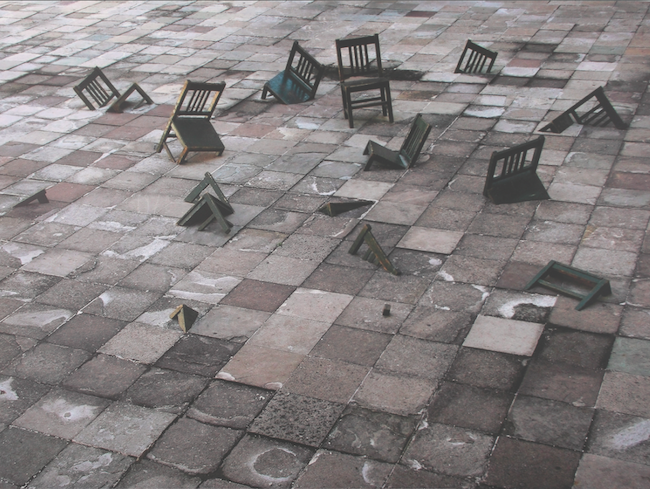
Ivan Puig. Crecimientos artificiales, 2009. Galila’s Collection. © the artist. Photo: Nicolas Suk. Exhibition “Entre deus chaises, un livre” at Boghossian Foundation - Villa Empain in 2014
You should add Maurizio Cattelan's work Him to that collection. It's a figure of Hitler on his knees, as if in prayer, and it's considered one of the most shocking post-war works of art devoted to this theme. Cattelan himself has even said that he wanted to destroy it several times while making it. In an interview with Christie's he said: “I changed my mind a thousand times, every day. Hitler is pure fear; it’s an image of terrible pain. It even hurts to pronounce his name. And yet that name has conquered my memory, it lives in my head, even if it remains taboo.”
That's one of the works I would like to have, because it is very strong. But I have something that's a little bit like a cousin to it. By Erwin Wurm. It's a block of stone that is like a human torso, and it's on its knees, in the same position as Cattelan’s Hitler. It doesn’t have a head, it's just square like this, but the title of the work is Pardon.
I've noticed that we're smiling almost the whole time that we're talking about your collection. Have there been situations in your life when you've looked upon a work of art or object and cried?
I don’t think so. I can think about tragic things without crying. Maybe because I also stopped crying in my life. That's something which is in a way painful, not to be able to cry. One of my assistants can cry all the time – she can cry about anything. And I'm sure that she feels relieved after crying. I can’t cry, maybe because I have so many responsibilities. And once you cry, you might fall. You have to be strong. And the only way to be strong is to not cry. So, maybe unconsciously I am not attracted to things that would make me cry. There is a lot of psychology in my choices. Maybe I want to avoid sad situations. Maybe one day when I will be ready to cry, it will happen. I don’t try to intellectualise too much.

Galila’s House. Photo:
But has art ever made you feel uncomfortable?
The only uncomfortable feeling for me is the fact that I don’t have any room in my home anymore. Art has taken it over. Actually, I sleep much better in a hotel room than at home. There's too much here. I have an apartment in Tel Aviv that has nothing else in it except for a mattress. I do not even have a proper bed there. And there is one chair in the living room. That’s all. I have some Israeli art on the wall, but I don’t have furniture, and I feel so good there. So, I go from this to nothing. It gives me a little bit of balance.
Is it important to you what happens to your collection after you're gone?
That's one of my questions now. In essence, there are two paths. One path is to talk to a museum and find out whether they'd be interested in the collection – the collection and also the art space that I'm creating right now. The other path is that I can say OK, these were my children while I was alive, and now they have to find a new home. So, I can organise a sale with an auction house after I die, but I can prepare it and make it like a story. That was my life, and now every piece will find a new family.
And everything will start again...
...in a different space and with a new life and new energy. Maybe other people will love these pieces. Because if you go to an auction and you buy a piece, you buy it because you like it. It's possible that these works of art will not be together anymore, at least not in the way that I've seen them, but that they'll find new homes. This is a possibility. But I do not deny that this is a problem I'm thinking a lot about right now.
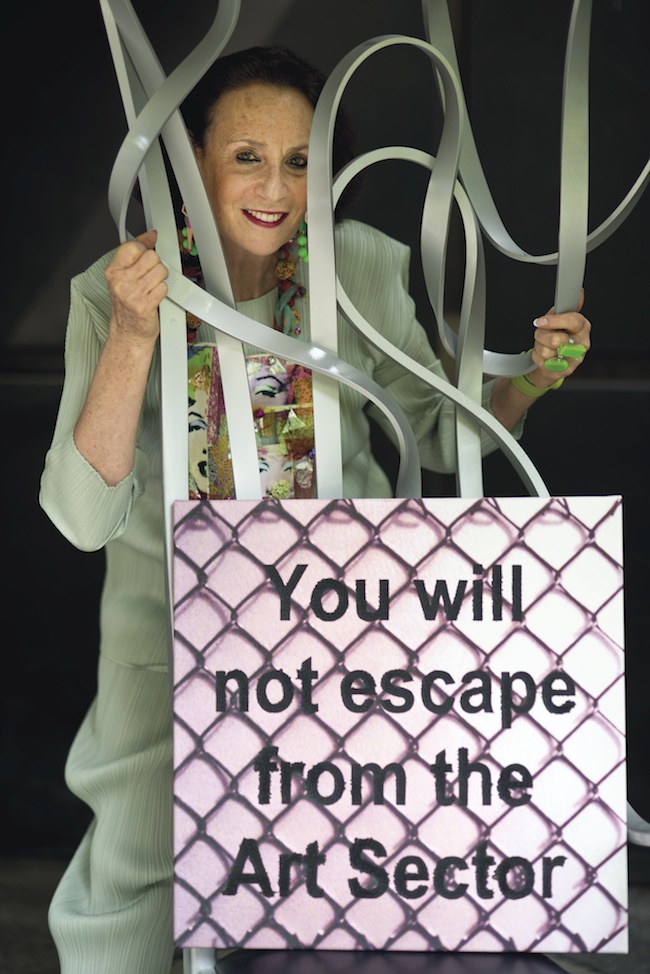
Galila Barzilaï Hollander. Photo: ©Christie’s Images
